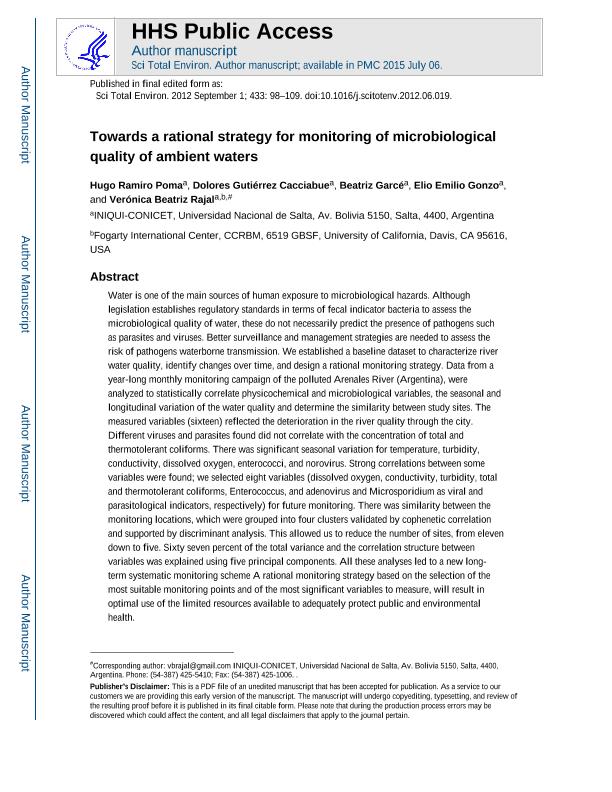Artículo
Towards a rational strategy for monitoring of microbiological quality of ambient waters
Poma, Hugo Ramiro ; Gutiérrez Cacciabue, Dolores
; Gutiérrez Cacciabue, Dolores ; Garces, Alicia Beatriz; Gonzo, Elio Emilio
; Garces, Alicia Beatriz; Gonzo, Elio Emilio ; Rajal, Verónica Beatriz
; Rajal, Verónica Beatriz
 ; Gutiérrez Cacciabue, Dolores
; Gutiérrez Cacciabue, Dolores ; Garces, Alicia Beatriz; Gonzo, Elio Emilio
; Garces, Alicia Beatriz; Gonzo, Elio Emilio ; Rajal, Verónica Beatriz
; Rajal, Verónica Beatriz
Fecha de publicación:
06/2012
Editorial:
Elsevier Science
Revista:
Science of the Total Environment
ISSN:
0048-9697
Idioma:
Inglés
Tipo de recurso:
Artículo publicado
Clasificación temática:
Resumen
Water is one of the main sources of human exposure to microbiological hazards. Although legislation establishes regulatory standards in terms of fecal indicator bacteria to assess the microbiological quality of water, these do not necessarily predict the presence of pathogens such as parasites and viruses. Better surveillance and management strategies are needed to assess the risk of pathogens waterborne transmission. We established a baseline dataset to characterize river water quality, identify changes over time, and design a rational monitoring strategy. Data from a year-long monthly monitoring campaign of the polluted Arenales River (Argentina), were analyzed to statistically correlate physicochemical and microbiological variables, the seasonal and longitudinal variation of the water quality and determine the similarity between study sites. The measured variables (sixteen) reflected the deterioration in the river quality through the city. Different viruses and parasites found did not correlate with the concentration of total and thermotolerant coliforms. There was significant seasonal variation for temperature, turbidity, conductivity, dissolved oxygen, enterococci, and norovirus. Strong correlations between some variables were found; we selected eight variables (dissolved oxygen, conductivity, turbidity, total and thermotolerant coliforms, Enterococcus, and adenovirus and Microsporidium as viral and parasitological indicators, respectively) for future monitoring. There was similarity between the monitoring locations, which were grouped into four clusters validated by cophenetic correlation and supported by discriminant analysis. This allowed us to reduce the number of sites, from eleven down to five. Sixty seven percent of the total variance and the correlation structure between variables was explained using five principal components. All these analyses led to a new long-term systematic monitoring scheme A rational monitoring strategy based on the selection of the most suitable monitoring points and of the most significant variables to measure, will result in optimal use of the limited resources available to adequately protect public and environmental health.
Archivos asociados
Licencia
Identificadores
Colecciones
Articulos(INIQUI)
Articulos de INST.DE INVEST.PARA LA INDUSTRIA QUIMICA (I)
Articulos de INST.DE INVEST.PARA LA INDUSTRIA QUIMICA (I)
Citación
Poma, Hugo Ramiro; Gutiérrez Cacciabue, Dolores; Garces, Alicia Beatriz; Gonzo, Elio Emilio; Rajal, Verónica Beatriz; Towards a rational strategy for monitoring of microbiological quality of ambient waters; Elsevier Science; Science of the Total Environment; 433; 6-2012; 98-109
Compartir
Altmétricas



